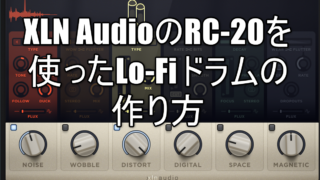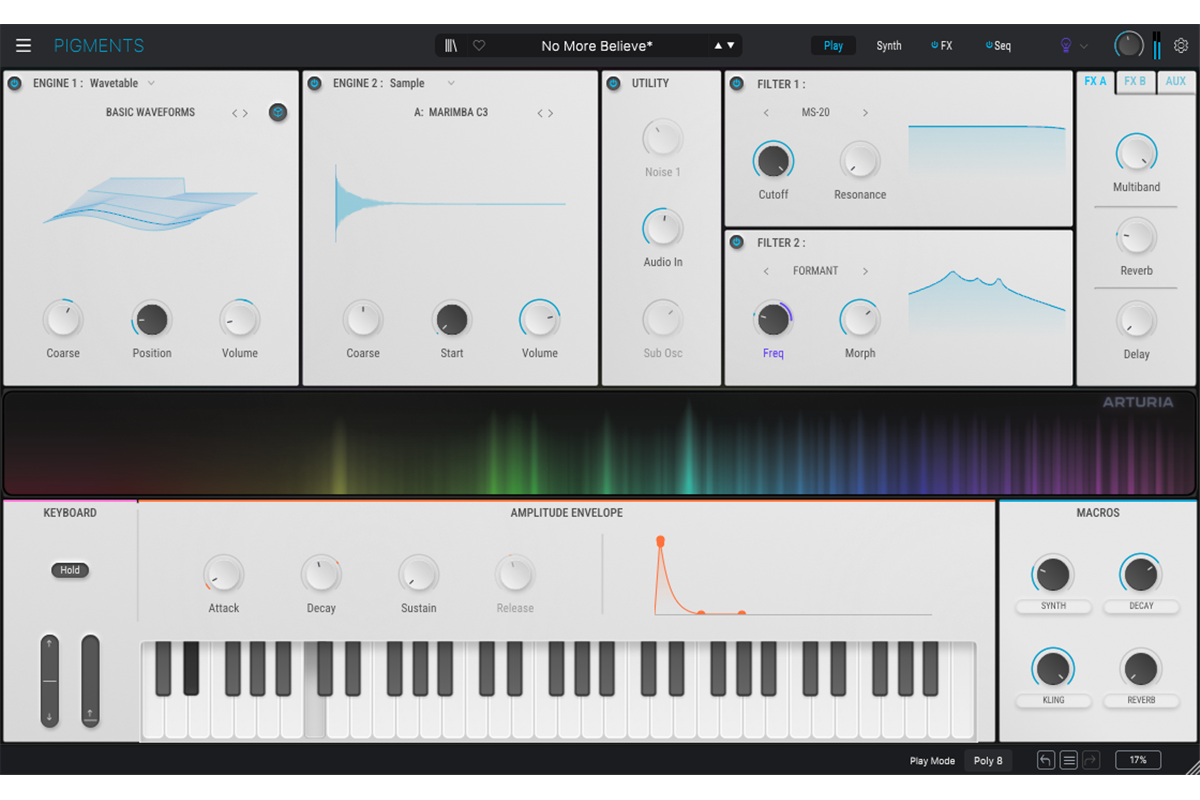セ ー ル 情報
RC-20 is personally one of my top 5 recommended Lo-Fi plug-ins.
After all, it is easy to use with a simple GUI, and you can efficiently realize the sound you want to make.
I like Lo-Fi, so I buy various Lo-Fi plug-ins, but RC-20 has an overwhelming majority of turns.
Sound demo
Personally, I especially use "Noise" and the "Follow" and "Duck" features are really great.
"Follow" can make noise at the timing when the sound is made.
Please watch the video.
And "Duck" can make noise after making a sound.
And the length of noise can be adjusted by adjusting "Follow".
Please watch the video.
I will briefly explain the six modules.
NOISE
You can choose from 16 types of noise in all.
The great thing is that it has a function like a noise gate, and when there is no sound, there is no noise.
WOBBLE
The point is the Wow / Flutter effect.
Gives fluctuations to the pitch.
DISTORT
This is quite powerful and can add distortion.
You can choose from XNUMX types of distortion.
DIGITAL
In short, it's a bit crusher, but this one is very good.
It is also installed in "DISTORT", but you can specify the frequency band to apply the effect with "Focus".
SPACE
A reverb with a strong metallic sound.
It is more suitable for creating a Lo-Fi feeling in combination with other modules than using this one.
MAGNETIC
This module simulates the change in volume that occurs when recording on magnetic tape.
If you combine this module with other modules, you can get a good Lo-Fi feeling.
Sale venue
I also write an article.
Overview
RC-20 Retro Color is a creative effects plug-in that adds life and texture to any recording.It easily recreates the warm and cozy feel of vintage recording equipment, but it also works perfectly in modern production environments.
System requirements
Mac
- macOS 10.9 or later (32 and 64-bit)
- Internet connection environment (only at the time of installation)
Format:
- VST, AU, AAX (32 & 64-bit)
Windows
- Windows 7, 8, 10 (32 and 64-bit)
- Internet connection environment (only at the time of installation)
Format:
- VST, AAX (32 & 64-bit)
Supported Hosts
This product runs on all hosts that support VST, AU, and AAX plug-ins. XLN Audio is actively testing the following host applications:
・ Ableton Live 9 & 10
・ Apple Logic Pro 9 & 10
Avid Pro Tools 11 or later (Pro Tools First is not supported)
・ Cakewalk by Bandlab
・ Propellerhead Reason 9.5 or later
・ Reaper 4 & 5
・ Steinberg Cubase 8 or later
Past sale information
・September 2023 $9
・July 2023 $8
・July 2022 $59.96 (tax included)
・ January 2022 $ 2 (tax included)
・ November 2021 $ 11 (excluding tax)
・ November 2021 $ 8 (excluding tax)
・ November 2021 $ 5 (excluding tax)
![[$69.96 until 2/16] XLN Audio's Lo-Fi plug-in RC-20 is on sale (30% OFF) 1 2021 11 19 17x06 59](https://chilloutwithbeats.com/wp-content/uploads/2021/10/2021-11-19_17h06_59.png)
![[$69.96 until 2/16] XLN Audio's Lo-Fi plug-in RC-20 is on sale (30% OFF) 5 2020 08 28 10x29 52](https://chilloutwithbeats.com/wp-content/uploads/2020/08/2020-08-28_10h29_52.png)




![[Free] Introduction to Soundfingers' piano sound source Dub Stage Piano 18 2024 02 12 23x34 12](https://chilloutwithbeats.com/wp-content/uploads/2024/02/2024-02-12_23h34_12.png)
Comment
I bought it from here yesterday because it was so cheap that it didn't come at this price for a while.
Recently, I've been studying how to use Phrasebox and around Bitwig and MIDI routing, so the sound design system hasn't changed much, but I hope I can use it.
It has a very good reputation, isn't it?I'm not the main Lo-fi, but I think it would be interesting if I could make something like changing from Lo-Fi to Hi-Fi by building up.
Thank you for your purchase!
Certainly this price is unlikely unless it is the next BF.
(It is doubtful that even BF will reach this price)
I've used Phrasebox for the first time in a while, but it's still good.
It depends on the code and it's easy to use.
It has a good reputation.
And I like it too.
It's a type that can reach the itch, so I think it can be used in various ways.
I tend to emphasize only Lo-Fi without permission ...
Certainly, from Lo-Fi to Hi-Fi is cool in build-up.
Bitwig is amazing.
I saw the following video, but you can do things like Stochas normally.
Also, FL Studio is good at flipping and changing the length on the piano roll, but it's good to be able to do it without opening the piano roll.
I wanted more and more.
https://youtu.be/vR-nbz8DJzI
Isn't something like Stochas the one that can allocate probabilities to notes?
Actually, this is Live's pakuri function w
In the case of Live, the establishment can be randomly assigned many times with the button, so Live is still better around random.
Bitwig is certainly better when it comes to editing MIDI and audio, and especially audio has a clip-like (event) in the clip, so I think it is very excellent as waveform editing software.
Anyway, this video is interesting, isn't it?
If you just stretch it normally, the timing of note-on will be covered, so it is not good, but the divine idea of shifting the timing of note-on by reversing is too amazing.
As a side note, you can do more interesting things with the Note Effect.
With a MIDI version of delay, pitch randomization, and a device to scale it, you can do more with your existing MIDI plug-ins.
Live around here is strong because it has M4L, but Bitwig can do various things in its original state, so I think that it is not defeated.
Yes, it is a probability allocation function for notes.
Oh, is that so?
Good things, you're taking advantage of each DAW!
I see, Live is also true.
However, I don't think Live is compatible with me, so I'm thinking of using Bitwig in parallel with FL.
This idea is good, isn't it?
I'm thinking of making this a blog post w
Of course, I will introduce the video as a source.
Is it a note effect?
It is big that it can be used as standard.
It's hard to throw away the existence of M4L in Live, but it's a little that Suite is required to use M4L.
I want to use Bitwig more, but the trial is only a few days away.
Should I buy it when the sale comes?
Well, it's annoying.
Bitwig is definitely the one I would recommend to people who are new to Live.
Sometimes it's PDC, but Live has some of the strongest things in theory, but it's not tolerant of anything other than its own, or it's slow to adopt technology, so Bitwig is better in total.
However, I want Bitwig to steal the good points.
LOBOTIX CHANNEL also started uploading Bitwig videos in his observation range.
https://www.youtube.com/channel/UCFqAACh4ESbHFzM11xh38jQ
It's not Bitwig main because it's a video centered on basic sound design, but it seems good to learn Bitwig because I announced on Twitter that I will upload a video of a notebook device tomorrow.
The notebook device that I personally find wonderful is the MIDI Receiver.
You can pull MIDI to the track as if it were a sidechain.
Normally, when sending MIDI to a plug-in, I think that I will create a MIDI track and put the output in the plug-in, but with this guy, I just put the Receiver in front of the plug-in I want to run with MIDI and sidechain it. Live in.
It's great that the tracks and routing are very simple.
Thank you for the information!
LOBOTIX CHANNEL It's good that it's easy to understand.
I also like it and am studying.
MIDI Receiver is amazing.
You don't need Bluecat's connector for routing in Bitwig.
(I bought a connector, but ...)